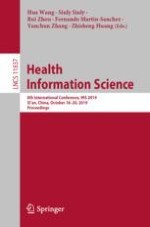2019 | Book
Health Information Science
8th International Conference, HIS 2019, Xi'an, China, October 18–20, 2019, Proceedings
Editors: Hua Wang, Siuly Siuly, Rui Zhou, Fernando Martin-Sanchez, Yanchun Zhang, Zhisheng Huang
Publisher: Springer International Publishing
Book Series : Lecture Notes in Computer Science
